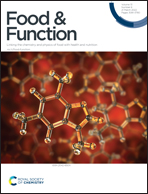Oil bodies extracted from high-oil soybeans (Glycine max) exhibited higher oxidative and physical stability than oil bodies from high-protein soybeans†
Abstract
Reports concerning the characteristics of soybean oil bodies (SOBs) isolated from high protein genotypes and high oil genotypes of soybeans available in the literature are insufficient and limiting. In this study, fatty acid compositions, total phenol and tocopherol contents, antioxidant capacity, and physicochemical stability of SOB emulsions recovered from three high-protein and three high-oil genotype soybeans were comparatively investigated. Principal component analysis showed that all six SOB samples could be easily discriminated based on the cultivar characteristics. Overall, the SOBs derived from the high-protein soybeans exhibited higher polyunsaturated fatty acid (PUFA) contents, while the SOBs derived from the high-oil soybeans had higher extraction yields and tocopherol contents; the tocopherol content was also positively correlated with the antioxidant capacity of the lipophilic fraction, but the difference in the total phenolic content between the two genotypes was not significant. The SOBs derived from the high-protein soybeans were more easily oxidized during storage, with 1.38- and 4-fold higher accumulation rates of lipid hydroperoxides (LPO) and thiobarbituric acid reactive substances (TBARS), respectively, in the high-protein-derived SOBs than in the high-oil-derived SOBs. In addition, the SOBs from the high-protein soybeans exhibited pronounced coalescence during storage, which was corroborated by focused confocal microscopy. These results confirmed that SOBs obtained from high-oil soybean genotypes are more suitable to manufacture OB-based products due to their superior physicochemical stability.

- This article is part of the themed collection: Food & Function HOT Articles 2022


 Please wait while we load your content...
Please wait while we load your content...